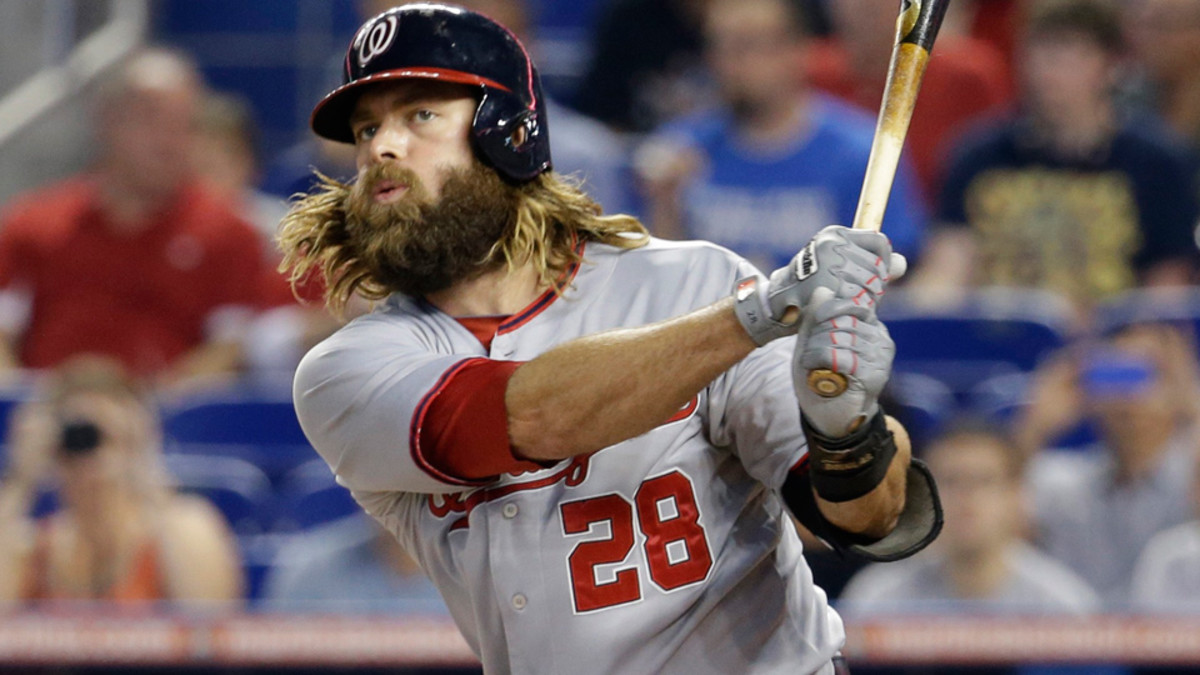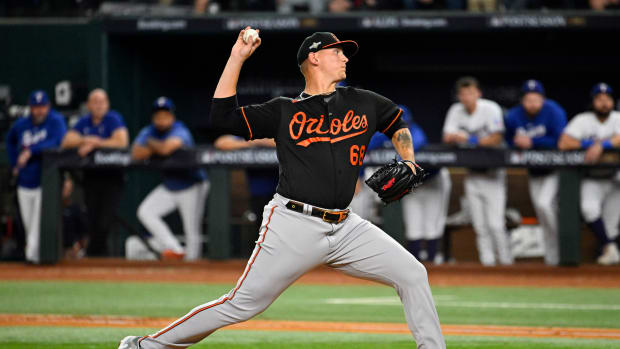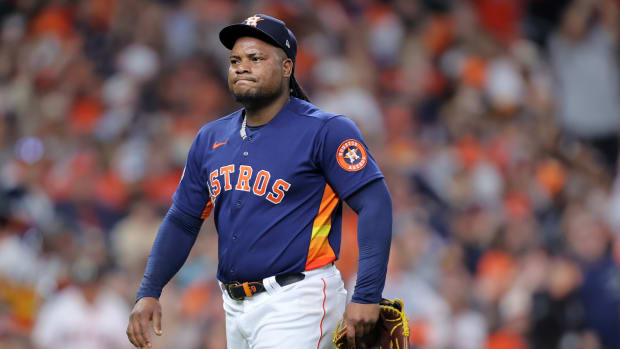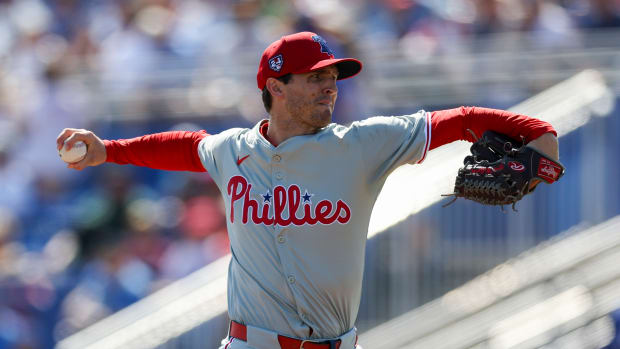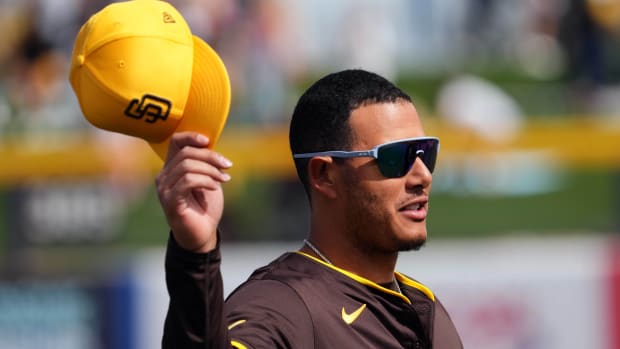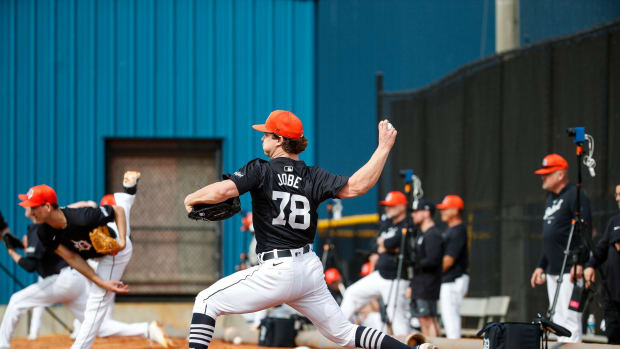Spring training preview: National League East
Over the next few days, SI.com will break down what to watch for in each team's camp as part of our spring training preview by looking at the Big Question, Big Position Battle and Big Prospect for all 30 clubs. Teams are listed by their order of finish from 2014. Note: The Big Prospect is a player who will be in major league camp but has not yet debuted in the major leagues.
• PREVIEWS: AL East
Nationals | Mets | Braves | Marlins | Phillies
Washington Nationals
The Big Question: Will Jayson Werth be ready for Opening Day?
Last August, Werth suffered an injury to the acromioclavicular (AC) joint in his right shoulder when he ran into the outfield wall at Nationals Park. He played through it effectively enough for the rest of the year, and it was assumed that rest would allow it to heal completely. However, the pain resurfaced during his offseason workouts, leading to arthoscopic surgery on Jan. 9. That procedure has a two- to three-month recovery time, so it's not a guarantee that Werth will be in the Opening Day lineup, and any setbacks in his recovery could eat into his season. Given the timing of the operation, the level and quality of Werth's participation in spring training should tell us a great deal about the progress of his rehabilitation.
The Big Battle: Closer
Winter Report Card: Washington Nationals
Setting aside any potential jockeying for Werth's vacated position in rightfield, the biggest roster question for the Nationals concerns the closer. Drew Storen is the incumbent and is expected to open the season with the job, but he has been shaky in the role in the past, with series-changing blown saves in each of the Nationals' two postseasons. New addition Casey Janssen has the most closing experience on the team, saving 81 games for Toronto over the last three years combined, but he showed significant signs of decline last year, and his modest contract (one year, $5 million) doesn't indicate any expectations of him filling the role for Washington. Sophomore Aaron Barrett closed in the minors, but also had a disastrous relief outing last postseason stemming in part from the control issues he displayed as a rookie. Storen's job is probably safe for now, but on a roster that's effectively setheading into camp, he seems like the most likely to play his way out of his current role.
• POWER RANKINGS: Nationals grab No. 1 spot heading into spring
The Big Prospect: A.J. Cole, RHP
Cole isn't the best pitching prospect in the Nationals' system — that honor belongs to 6'6" righty Lucas Giolito. However, the 20-year old Giolito is still a long way from the majors (he'll likely begin the season in High A) and was not on the list of non-roster invitees the Nationals announced last Thursday. The well-traveled Cole was drafted by Washington in the fourth round in 2010, sent to the Athletics in the Gio Gonzalez trade, then re-acquired 13 months later in the three-way deal that sent Mike Morse to Seattle. Still just 23, Cole ranked 30th on Baseball Prospectus' list of top prospects, is on the 40-man roster and has 11 Triple A starts under his belt. On any other team, he'd be a potential factor this season. But with the Nationals' present rotation set, Cole, as much as swingman Tanner Roark, may be why Washington is unconcerned about the impending free agency of starting pitcher Doug Fister.
New York Mets
The Big Question: How will Matt Harvey's elbow hold up under game conditions?
Of the many pitchers due to return from Tommy John surgery in the coming season, none is better positioned to get back to his previous form than Harvey. Nearly 18 months will have elapsed between Harvey's surgery and his first start of the coming season, which the Mets are reportedly delaying until their home opener on April 13, in part to help limit his innings. What's more, other than Miami's Jose Fernandez, no returning Tommy John recipient's previous form was more impressive than that of Harvey, who in 2013 started the All-Star Game, led the NL in fielding independent pitching and finished fourth in the Cy Young voting despite the fact that his season ended in August because of that elbow injury.
Harvey, who was back to throwing 95 mph last August, threw his first bullpen of the spring last Wednesday and is expected to be on pace with the Mets' other starters in camp, but every increase in effort, pitch count and competition will be a test. His progress could determine whether or not New York continues to search for a taker for Dillon Gee, who would be pushed out of the rotation by Harvey's return.
• WATCH: Are Mets finally ready to join ranks of contenders in 2015?
The Big Battle: Shortstop
In Ruben Tejada, the Mets have a slick-fielding 25-year-old shortstop with a knack for getting on base. However, due to what appear to be personality conflicts and a lost 2013 in which he was sent down after a bad month and a half, they have been desperate to replace him. As a result, New York is reportedly going into camp hoping that 23-year-old Wilmer Flores can nail down the job.
Winter Report Card: New York Mets
Setting aside perceptions of personality and work ethic, Flores has the primary thing Tejada lacks: power. A career .294/.340/.439 hitter in the minors, Flores has been working his way up through the Mets' system since he was 16 and has 15-homer power. But there are serious questions about his ability to play shortstop, a position he didn't play at all in 2012 and '13. Indeed, per ESPN's Adam Rubin, the Mets have acknowledged internally that Tejada would be the better choice to start behind Jonathon Niese, who tends to induce more groundballs than the team's other starters.
Another player who could get an extended look at short this spring is 2012 second-round pick Matt Reynolds, who had an outstanding offensive season last year (.343/.405/.454 at Double and Triple A) but is limited defensively and thus not regarded as a top prospect. The 24-year-old Reynolds is in camp as a non-roster invitee, so he has an extra hurdle to clear to win a share of the job.
The Big Prospect: Noah Syndergaard, RHP
Snydergaard is one of the top pitching prospects in all of baseball and ranks ninth among all prospects on BP's list. He is expected to be fronting the Mets' rotation along with Harvey no later than 2016. Acquired in the R.A. Dickey trade, the 6'6" Syndergaard made 26 starts in Triple A last year, and while the results (9-7, 4.60 ERA) were underwhelming, he will get plenty of time to work out the kinks in a repeat of the level this year. Still, Syndergaard is expected to make his major league debut at some point this season and seems likely to replace Bartolo Colon in the rotation no later than September.
Atlanta Braves
The Big Question: Who is Dian Toscano, and is he ready to be the Braves' leftfielder?
Signed for just $6 million over four years, Toscano, a 25-year-old Cuban defector, is not considered a likely star. However, with leftfield wide open following the trade of Justin Upton to San Diego, the lefthanded Toscano will be given a chance to make the major league roster out of camp. The real question is whether he'll be the everyday leftfielder, the strong-side of a platoon with righty Jonny Gomes, or a fourth outfielder? Some believe the latter option may be his ultimate role in the major leagues.
Winter Report Card: Atlanta Braves
As little as we know about most Cuban defectors, we know even less about Toscano. He did not play for the Cuban national team, has yet to play competitively outside of his native country and was not a hotly-pursued commodity whose workouts were well-populated and circulated via video. A .300/.403/.427 hitter in five seasons in Cuba's Serie Nacional, Toscano compiled just 736 at-bats across those five seasons, the last of which came in the winter of 2012-13. In that sample, he exhibited little power or speed on the bases, but hit for good averages and walked more often than he struck out. Per Baseball America's Ben Badler, who first reported the signing in early December, Toscano has a weak throwing arm but good range afield and is "in significantly better shape and has increased his strength since leaving Cuba." That suggests he might show more power as a 25-year-old in the majors than he did as a 19-to-23-year-old in Cuba.
The Big Battle: Second base
Signed to a one-year, $3 million contract, Alberto Callaspo is the default veteran fill-in at second base, but he's hardly guaranteed the job coming off a dismal .223/.290/.290 performance last year. In fact, the Braves might prefer to see Jace Peterson, the soon-to-be-25-year-old infielder acquired from the Padres in the Upton deal, steal the position. Peterson didn't hit a lick in a 58-plate-appearance debut for San Diego last year, but he is a former compensation-round pick and a career .287/.381/.411 hitter in the minors with speed on the bases and enough skill in the field to have been a shortstop.
Other options at second include sophomore utility man Phil Gosselin, who made frequent starts at the position down the stretch last year; and non-roster invitee and former Braves second-sacker Kelly Johnson, who out-hit Callaspo last year and was the more valuable player in each of the last two seasons as measured by Baseball-Reference's Wins Above Replacement. Also worth considering is a potential platoon with the righty Gosselin on the short-side complementing lefties Pederson or Johnson, or the switch-hitting Callaspo.
• VERDUCCI: Picking the 10 biggest storylines to watch for spring
The Big Prospect: Jose Peraza, 2B
Whoever wins the second base job will ultimately have to yield to Peraza, a Venezuelan shortstop who moved across the bag last year and is on track to take over the keystone in 2016 at the age of 22. A slick fielder who has hit .306 in 343 minor league games and stole 60 or more bases with a success rate of 80 percent or better in each of the last two seasons, Peraza excelled after a mid-June promotion to Double A last year and was rated the Braves' top prospect by BA in December. His plate production lacks patience or power, but his speed, defense and consistent ability to hit for average should make him a player whose strengths can be easily observed in a small spring sample.
Miami Marlins
The Big Question: How will Giancarlo Stanton react to a game-speed fastball up and in?
The concern heading into camp about the health of offseason addition Mat Latos' pitching elbow might be more warranted, but Stanton is the key piece to the Marlins' hopes. Last year's runner-up for NL Most Valuable Player honors and the recipient of the richest contract in major league history in November, Stanton has not faced game-speed pitching since being hit in the face by a fastball from Milwaukee's Mike Fiers last Sept. 11. Chances are Stanton will be just fine, but he will be wearing a faceguard on his helmet, which will serve as a constant reminder of how his season came to an end.
Beyond that, even Stanton won't really know how that pitch from Fiers rewired his brain until another pitch comes up and in at game speed, and despite assurances from his doctors, he can't be sure that his eyesight was completely unaffected until he tests his reactions and hand-eye coordination against major league pitching. Even if Stanton is unlikely to have any lingering issues from the pitch, not knowing for sure is scary. The sooner Stanton can get over the hump of facing live pitching, the better.
• WATCH: Picking the biggest winners, losers of free agency
The Big Battle: Catcher
Like the Nationals, the Marlins' roster is fairly well set outside of the last couple of spots in the bullpen and on the bench. With Dan Haren apparently having accepted the fact that he'll be pitching his home games outside of southern California, the projected starter most likely to lose his job is catcher Jarrod Saltalamacchia, who was replacement level in the first season of his three-year deal with Miami and will be pressured from below by the organization's second-best prospect, J.T. Realmuto. Yes, the Marlins still owe Saltalamacchia $15 million for the next two seasons, but as the Stanton contract and their uncharacteristically aggressive offseason suggest, the organization is in win-now mode and enters 2015 with hopes of its first winning season since 2009.
Winter Report Card: Miami Marlins
Saltalamacchia not only saw his power evaporate last season, but he also threw out just 19 percent of opposing base runners (against a league average of 28 percent), was a poor pitch-blocker and was the very worst pitch-framer in the majors according to BP's metrics. By comparison, Realmuto, who will be 24 in April and appeared in 11 major league games last year, has thrown out 38 percent of opposing basestealers in his minor league career. He may not offer more power, but he has a better all-around plate approach, resulting in more and better contact, and adds a few stolen bases to boot. Saltalamacchia will most likely be the Opening Day catcher no matter what happens in camp, but a strong showing from Realmuto in March could make Salty's leash extremely short.
The Big Prospect: Jose Urena, RHP
Urena isn't particularly exciting. A 23-year-old righty starter with a mid-90s fastball, a solid changeup and good control, but below-average strikeout rates, he may ultimately wind up a late-inning reliever due to his lack of a reliable third pitch and in-game durability. Indeed, with Urena set to start the season in Triple A, he seems far more likely to reach the majors this season in a relief role, which could find him throwing in the upper-90s, than as a starter. Pay attention to his slider in camp; that's the pitch that could make the difference for him.
Philadelphia Phillies
The Big Question: Is Cliff Lee healthy?
Lee made just three starts after May 18 due to flexor strains in his forearm and elbow, with the latter ending his season on July 31. Lee, who averaged 236 innings over the previous six seasons (postseason included) is now 36 and entering the walk year of his contract, and the Phillies and their fans can be forgiven if they're having flashbacks to the unexpected end to Roy Halladay's career. Halladay ran out of gas in his walk year and age-36 season, one year removed from a dominant six-year run in which he averaged 242 innings per season (postseason included).
Winter Report Card: Philadelphia Phillies
Halladay's end was difficult for all baseball fans, but contractually, the timing was just right for Philadelphia. Lee, however, has an option with a $12.5 million buyout for 2016, meaning the Phillies owe him $37.5 million even if he never throws another pitch. At this point, the rebuilding Phils would surely be willing to pay a significant portion of that to make Lee — whose option would vest at $27.5 million if he rebounds and throws 200 innings this season — someone else's problem. But the former Cy Young winner has to prove he's healthy first.
• WATCH: Will rebuilding Phillies move Hamels before season starts?
The Big Battle: Third base
The Phillies' top hitting prospect, Maikel Franco, made his major league debut last September, and while he didn't impress in that 16-game cup of coffee or at Triple A (.257/.299/.428 with 16 home runs), incumbent Cody Asche was no better and lacks upside potential. Franco is just 22, and the Phillies are no threat to contend this year, so there's no need to rush him if the front office thinks a repeat of Triple A will be to his benefit. Still, Asche isn't enough of an obstacle to prevent Franco from winning the third base job with a monster performance in camp.
The Big Prospect: Aaron Nola, RHP
The list of non-roster invitees announced by the Phillies thus far suspiciously includes no homegrown prospects, suggesting that more names will be coming soon. Given that, I'm going to go off the list with Nola, who was ranked the team's second-best prospect by both BA and BP this offseason after being drafted out of Louisiana State with the seventh pick in June and reaching Double A in August. Nola, who despite his seemingly apt last name is from Baton Rouge, is the sort of low-ceiling, command-and-control pitching prospect who arrived in the minors nearly big-league ready, so it wouldn't be a complete shock to see him in the majors at some point this season. What would be a shock is if he is not in major league camp this spring.






























